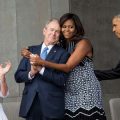National Museum of African American History and Culture celebrates first anniversary
The museum opened a year ago to unprecedented interest and acclaim. Join the anniversary celebration with a weekend of free events and performances Sept. 23–24, as well as a special panel discussion with the Little Rock Nine, the students who integrated Little Rock Central High School in 1957.
A year ago this month, the National Museum of African American History and Culture opened on the National Mall, becoming the largest cultural destination devoted to exploring and displaying the African American story. In its inaugural year, the museum has welcomed nearly 3 million visitors through its doors, increased the number of items in its permanent collection to nearly 40,000 and hosted 46 public programs to help visitors understand historic and contemporary issues. To commemorate the first anniversary, the museum is inviting the public to two Community Day celebrations Sept. 23–24 featuring free activities on the museum’s grounds and encourages the community to join the #VisitorVoices social media campaign. The museum’s hours will be extended to 7:30 p.m. for the anniversary weekend only.
The VisitorVoices campaign invites audiences to share aspects of their visit on YouTube, Facebook, Twitter and Instagram using the hashtag #VisitorVoices. This campaign highlights stories from Reflection Booths inside the museum that allow visitors the opportunity to share their experience with the exhibitions on video testimonials. #VisitorVoices helps everyday people see themselves as part of the museum’s history and community.
The first Community Day begins at 10 a.m. Saturday, Sept. 23, with several performances taking place on the museum grounds. Scheduled performers include Ballou High School’s Majestic Knights Marching Band, KanKouran West African Dance Company, Experience Unlimited and GR!DC (Girls Rock DC). From 11 a.m. to 1: p.m., the Smithsonian’s horticulture staff will lead garden tours on the museum grounds. For visitors who have reserved passes to enter the museum, puppeteer Schroeder Cherry will present Puppets in the Gallery. Cherry, a Washington, D.C., native, has performed original shows with puppets in museums, libraries and cultural centers for adults and children across America.
The second Community Day begins at 11 a.m. Sunday, Sept. 24. Scheduled bands include Afro-Brazilian band Batala Washington, jazz performer Rochelle Rice and hip-hop artist Christylez Bacon. From 11 a.m. to 1 p.m., the horticulture staff will continue the tours, and Diane Macklin will present Stories by Diane Macklin. Macklin is a master storyteller and American griot who weaves stories from the African American diaspora. For members of public with reserved passes, the museum will present numerous activities inside, including performances by StepAfrika and Capitol Tap and activities designed to reveal the stories behind objects in the galleries.
“Reflections of the Little Rock Nine 1957–2017” concludes the first anniversary celebration at 7 p.m. Tuesday, Sept. 26. This panel discussion will feature six of the nine students who integrated Little Rock Central High School of Little Rock, Ark., in 1957, following the U.S. Supreme Court’s Brown v. Board of Education decision banning school segregation. Registration is recommended at http://bit.ly/2eU1AkQ

Soldiers from the 101st Airborne Division escort the Little Rock Nine students into the all-white Central High School in Little Rock, Ark., in September 1957. The students were Ernest Green (b. 1941), Elizabeth Eckford (b. 1941), Jefferson Thomas (1942–2010), Terrence Roberts (b. 1941), Carlotta Walls LaNier (b. 1942), Minnijean Brown (b. 1941), Gloria Ray Karlmark (b. 1942), Thelma Mothershed (b. 1940), and Melba Pattillo Beals (b. 1941) Ernest Green was the first African American to graduate from Central High School. (Photo via National Archives)
“We are so grateful to America for making this first year unprecedentedly successful,” said Lonnie G. Bunch III, founding director of the museum. “This first anniversary gives us at the Smithsonian the opportunity to thank everyone for this incredible gift and for making it possible to continue our mission to help America grapple with history by seeing their past through an African American lens—and ultimately help Americans find healing and reconciliation.”
Posted: 14 September 2017









